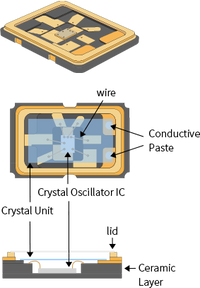Timing device
What is a crystal oscillator?
In contrast to semiconductors, which are known as the "rice of industry" due to their crucial importance to electronic devices, crystal oscillators are also known as the "salt of industry," and are used in all types
of electronic devices, most notably smart phones. A crystal oscillator is a package containing a crystal resonator, which uses the piezoelectricity of a crystal to generate a certain frequency, and a circuit for oscillating the resonator, and this circuit is called a crystal oscillator IC. Components making up electronic devices number in the hundreds to tens of
thousands, but they are not free to move on their own. Each component moves in step and according to a certain rhythm, and the clock assumes the role of
conducting it all. The clock is to provide a constant timing signal at a precise time and speed, and the device that creates
this clock is the crystal oscillator. Although a clock is an extremely small component, it plays a very important role, and there are many types of clocks with different configurations, features, and operating specifications, depending on how
they are integrated into the electronic equipment. It is also drawing considerable attention as an electronic component that will play an important role in
the coming 5G era.
Sensor
Infrared sensors are sensor modules that convert the infrared (wavelengths from 0.78 to 1000 µm) energy emitted by an object into radiant temperature and output it.
The principle of infrared sensors can be divided into thermal and quantum types, and our products are classified as thermal.
The thermoelectromotive force (thermopile: thermoelectromotive effect) is used to detect the absolute amount of energy (temperature) when the infrared radiation emitted from an object is received.
Thermopile-type infrared sensors consist of a silicon (Si) lens, an array sensor and a control IC, and are characterised by their ability to observe an object from a distance with high accuracy and low power consumption.
Have you ever had the experience of a light automatically switching on when you enter a toilet, only to turn off when you remain still in the private room?
In contrast to pyroelectric sensors, which become stable and stop responding when the object is stationary, thermopile sensors are suitable for fixed-point observations because they continue to capture radiant energy.
Optical encoders are sensor modules that detect how far an object has moved, its position and displacement, and can measure horizontal and vertical linear (linear) and rotary (rotary) movement depending on the shape of the combined scale.
The encoder principle includes magnetic and electromagnetic induction, but our products are optical, which can be adapted to a wide range of industries. Optical encoders consist of an LED light-emitting element, a light-receiving element and a control IC, and are characterised by extremely low wear and deterioration and high reliability, as they can be installed non-contact to the object. To measure the amount of movement, LED light is irradiated onto a pattern on a linear or rotary scale fixed to the object, the reflection of which is received by the light-receiving element, converted into an electronic signal and output. The signal emitted from the light-receiving element contains A- and B-phase channels, with the B-phase outputting 1/4 cycle later than the A-phase, and the direction of travel or rotation can be determined by determining the channel that rises first. The structure of optical encoders can be either transmissive, where a scale is sandwiched between the light emitter and receiver, or reflective, where the light emitter and receiver are integrated into a single unit.

